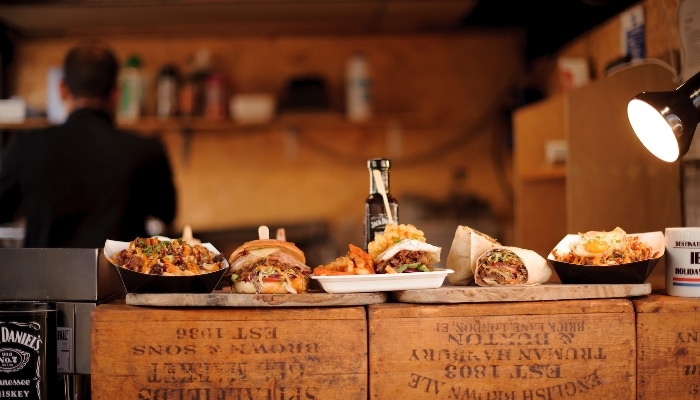Shedding Light on “Dark” Kitchens: What Restaurateurs Should Know
Dark kitchens have taken the food service industry by storm, but how beneficial are these delivery and takeout operations for existing restaurants?
The dark kitchen concept has proven profitable for some eateries looking to expand. However, restaurateurs must consider the pros and cons before diving in.
What Are Dark Kitchens?
Dark kitchens, ghost kitchens, cloud kitchens or virtual kitchens have reshaped the food industry. Some operate out of an established restaurant or a different structure entirely.
Rather than use a storefront and dining room, they lean into mobile food delivery apps and third-party service providers to offer delivery and pickup only. The unique setup allows flexibility in menu items and brands, targeting various demographics and preferences.
Some of the more popular dark kitchen concepts include:
- Cosmic Wings and Neighborhood Wings, operated by Applebee’s
- Chicken Sammy’s, operated by Red Robin
- Tender Shack, operated by Outback Steakhouse
- Rotisserie Roast, operated by Boston Market
- It’s Just Wings, operated by Chili’s
The Ghost Kitchen Phenomenon
The global market for ghost kitchens reached $56.71 billion in 2021, with forecasts showing possible growth trends. During the COVID-19 pandemic, dark kitchens appeared everywhere as the food service sector closed its doors. New technologies and mobile food delivery apps paved the way for this niche market.
Venture capitalists subsidize numerous dark kitchen startups. For instance, Reef Technology raised $700 million through Softbank, promising to help brands embrace the dark kitchen model themselves. However, not every company sees the potential in dark kitchens.
By the time Wendy’s announced it would open 700 ghost kitchens across North America and the United Kingdom by 2025, Reef Technology had already helped it open eight locations in Canada. Since then, Wendy’s has backtracked, opting to move away from dark kitchens. BurgerFi and GoPuff also scaled down their partnerships with Reef.
Advantages of Dark Kitchens
Customers love new concepts in food service, and ghost kitchens are one of the more unique food delivery models. As such, many restaurants continue exploring these kitchen establishments for their operations. Here are four advantages of starting one.
1. Caters to Demand for Online Delivery
Online food delivery service is here to stay, with 53% of American adults saying food delivery or takeout is essential to their lifestyle. The number is significant, exacerbated by the pandemic.
As a strictly takeout or delivery type of establishment, ghost kitchens have demonstrated their ability to fulfill customer demands.
2. Reduced Operating Costs
Another benefit of not having a dining space is the lower operating costs. Ghost kitchens are solely kitchens, meaning they need far less square footage than restaurants or fast food chains.
In addition to not having a dining room, a dark kitchen lacks a storefront and front-of-house staff, meaning there are fewer employees to pay.
3. Ability to Expand to Multiple Locations
There will always be challenges in opening new locations, but efficiency and lower overhead costs make scalability easier to achieve. Once dark kitchens can streamline their business operations and processes, they can duplicate it elsewhere.
Of course, while they’ll need to ensure a customer base and high demand, dark kitchen owners have less to worry about regarding curb appeal and where to lease.
4. Capable of Selling Multiple Brands and Cuisines Under One Roof
Multiple brands can set up in a shared kitchen space with designated areas for different cuisines. Each brand in a ghost kitchen has its own equipment, inventory and offerings. Many use new technologies to separate logistics more efficiently, while other brands pool resources, such as storage and refrigeration, ingredients, and packaging areas.
Having different brands and cuisines at one site makes it easier to appease various tastes. For example, one brand might offer gourmet burgers and American cuisine while another strictly serves menu items for dieters.
Disadvantages of Dark Kitchens
With food delivery a hard convenience to let go of, it seems dark kitchens are here to stay. However, not everything is smooth sailing for these operations. Here are a few disadvantages to consider.
1. Lacking Physical Dining Space
Unlike traditional eateries, the lack of dining space can decrease customer satisfaction. Some of these kitchens have drive-through windows for customers. Others operate with deliveries only.
People still love to eat out, making it harder for ghost kitchens to establish a loyal customer base or communicate effectively.
2. Difficulty Meeting Compliance and Regulations
A brick-and-mortar restaurant with traditional dining has a system in place to ensure health and safety for everyone. Dark kitchens may have more difficulty meeting compliance and regulatory requirements.
Delivery hygiene, temperature control and the transfer of allergen information are key challenges for dark kitchen operators. For instance, they don’t have the luxury of interacting with customers directly to inform them of potential allergens and cross-contamination.
3. Harder Time Maintaining Food Quality and Service
There is almost zero oversight once food orders leave the dark kitchen with third-party delivery personnel.
Dark kitchens cannot control prolonged delivery or issues with packaging during transport, decreasing customer satisfaction. Food may be cold, muddled or spilling over when it arrives at its destination.
Dark kitchens also tend to endure more setbacks in preparation and delivery because they cater to more widespread demographics.
4. Greater Reliance on Food Delivery Platforms
Customers love using food delivery platforms and services out of convenience, but they can be a real headache for ghost kitchens. Commission fees vary by service but tend to eat away at profits.
Dark kitchens must also rely on delivery partners to uphold excellent customer experiences, which could otherwise hinder a dark kitchen’s reputation. Likewise, limited customer interactions, technical glitches and disruptions, and negative customer reviews reflect poorly on businesses.
Is a Dark Kitchen Suitable for Your Restaurant?
Some eateries do excellent business in their dark kitchen operations. Others have to find their footing. It’s important to weigh the pros and cons of starting one, as they’re not the most suitable endeavor for every restaurant.



Comments are closed.